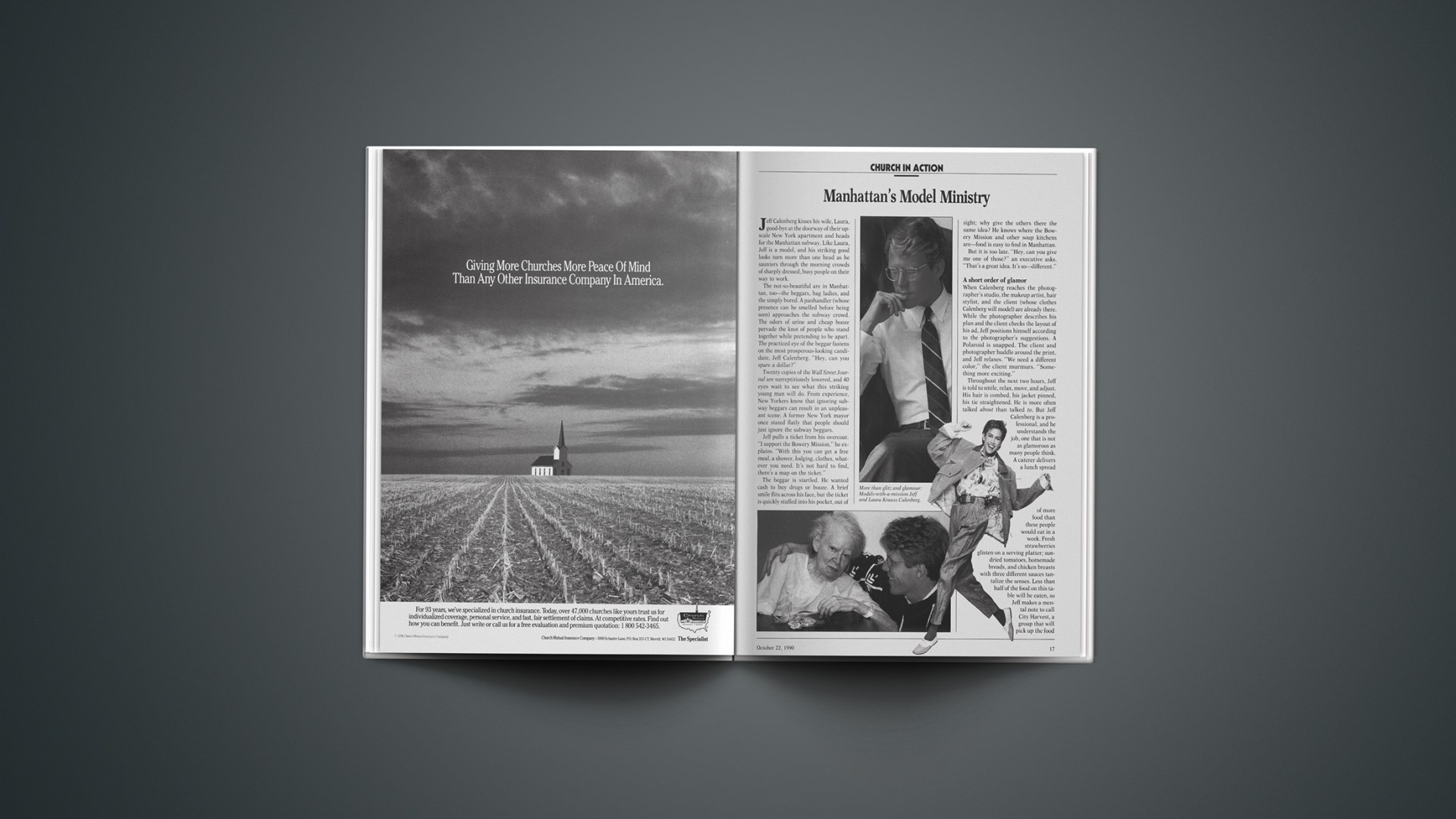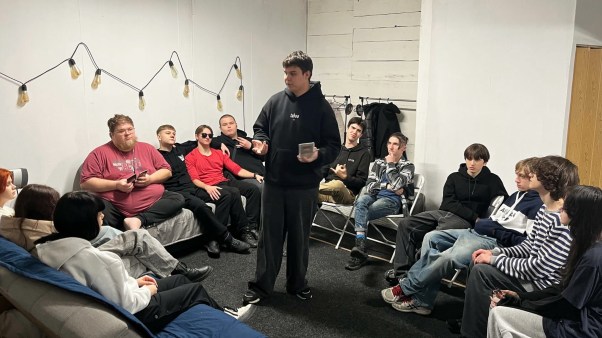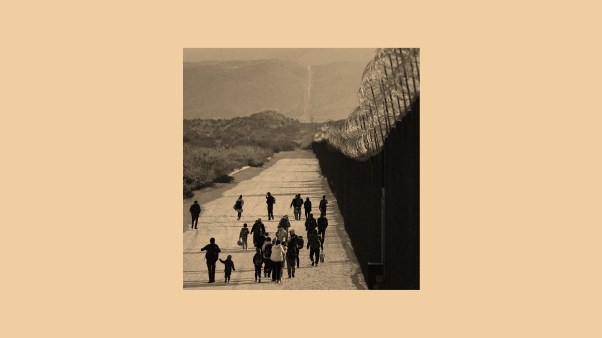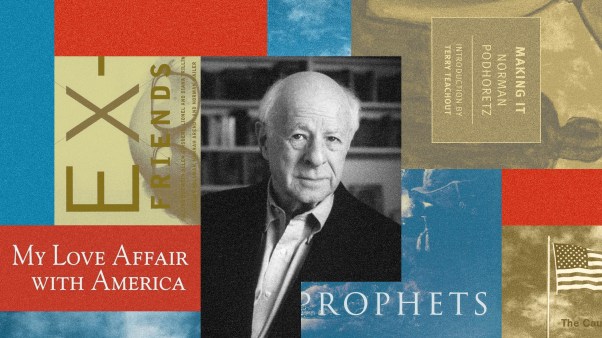Jeff Calenberg kisses his wife, Laura, good-bye at the doorway of their upscale New York apartment and heads for the Manhattan subway. Like Laura, Jeff is a model, and his striking good looks turn more than one head as he saunters through the morning crowds of sharply dressed, busy people on their way to work.
The not-so-beautiful are in Manhattan, too—the beggars, bag ladies, and the simply bored. A panhandler (whose presence can be smelled before being seen) approaches the subway crowd. The odors of urine and cheap booze pervade the knot of people who stand together while pretending to be apart. The practiced eye of the beggar fastens on the most prosperous-looking candidate, Jeff Calenberg. “Hey, can you spare a dollar?”
Twenty copies of the Wall Street Journal are surreptitiously lowered, and 40 eyes wait to see what this striking young man will do. From experience, New Yorkers know that ignoring subway beggars can result in an unpleasant scene. A former New York mayor once stated flatly that people should just ignore the subway beggars.
Jeff pulls a ticket from his overcoat. “I support the Bowery Mission,” he explains. “With this you can get a free meal, a shower, lodging, clothes, whatever you need. It’s not hard to find, there’s a map on the ticket.”
The beggar is startled. He wanted cash to buy drugs or booze. A brief smile flits across his face, but the ticket is quickly stuffed into his pocket, out of sight; why give the others there the same idea? He knows where the Bowery Mission and other soup kitchens are—food is easy to find in Manhattan.
But it is too late. “Hey, can you give me one of those?” an executive asks. “That’s a great idea. It’s so—different.”
A Short Order Of Glamor
When Calenberg reaches the photographer’s studio, the makeup artist, hair stylist, and the client (whose clothes Calenberg will model) are already there. While the photographer describes his plan and the client checks the layout of his ad, Jeff positions himself according to the photographer’s suggestions. A Polaroid is snapped. The client and photographer huddle around the print, and Jeff relaxes. “We need a different color,” the client murmurs. “Something more exciting.”
Throughout the next two hours, Jeff is told to smile, relax, move, and adjust. His hair is combed, his jacket pinned, his tie straightened. He is more often talked about than talked to. But Jeff Calenberg is a professional, and he understands the job, one that is not as glamorous as many people think. A caterer delivers a lunch spread of more food than these people would eat in a week. Fresh strawberries glisten on a serving platter; sun-dried tomatoes, homemade breads, and chicken breasts with three different sauces tantalize the senses. Less than half of the food on this table will be eaten, so Jeff makes a mental note to call City Harvest, a group that will pick up the food and deliver it to soup kitchens.
Jeff and Laura Calenberg, featured in the New York Times, J. C. Penney catalogs, European fashion magazines, and ads for Hanes and American Express, are models with a mission: they want their faith to be a light in the dark and empty world of Manhattan’s elite.
For Jeff, the concern for things spiritual began in the Christian home in which he grew up. He spent three years in a Bible college and graduated from a Christian liberal arts college. “If you had told me during my Bible college days that I’d be a model, I would have laughed,” he admits.
After graduation, Calenberg traveled across the world with only a backpack. In Milan, Italy, the international capital of fashion, he began to model. At first it didn’t seem possible that God could bless a career in modeling.
But Jeff began to see modeling as a career with opportunity for ministry. While in Italy he put together a gospel tract designed specifically to appeal to models, signing it, “Models for Christ.”
In 1984 he came to New York and signed with a prestigious modeling agency. While assisting a Bible-study group for actors, he learned that another Christian model was working for his agency. He sought her out, and before long he and Laura Krauss began the twice-monthly meetings of Models for Christ. They were married in 1986.
“The Poor Will Watch”
Impact, the name Models for Christ uses for public ministry, now also reaches professional people in a variety of occupations. “Our meetings are primarily evangelistic,” says Jeff. “We encourage Christians to bring their coworkers for a contemporary presentation of the gospel.”
Impact also organizes a project each month that literally puts people on the streets. One month they organized a food and clothing distribution for the Bowery mission. Another month they visited AIDS patients.
A few blocks away from the Impact meeting place, the 70-year-old Reverend Clayton Dunlop runs Saint Paul’s house, an aging brownstone that serves as a nighttime shelter for the homeless. Dunlop is tall and thin, and his ankles are swollen from walking up and down the five flights of stairs in his building. For 40 years, he has given himself to the needs of the homeless, and if his ankles are giving out, well, so is the rest of the building. He appears to have spent his years worrying more about feeding lunch every day to 300 needy people than about painting the foyer.
Last March Impact organized a work night at Saint Paul’s house. A homeless woman standing outside Saint Paul’s stood in marked contrast to the workers who arrived that night. Stunning young men and women, all casually but beautifully dressed, stepped out of cabs and walked toward the shelter. One young man was a successful contractor. Several actors and actresses had already arrived, as had a graphic designer and an architect.
Then they got down on their hands and knees and began to pull up an old, aqua carpet that smelled pungent and rained dust on them. Once the carpet was up, several workers began patching, repairing, and laying glue for new linoleum tiles. Others went upstairs and scrubbed bathrooms. One woman installed new toilet seats and shower curtains.
It was after midnight when the last worker left. The next morning, as Jeff and Laura went to their jobs with the other “beautiful people,” they thought of Dunlop, who was probably shuffling over the new flooring without even looking down. Many of the tired and hungry who used the shelter might not notice the results of the efforts of the night before.
But for others, the work would be a sign of Christ’s love in action. “God is calling his people to go out and be Christ to people,” Laura says. “The world isn’t necessarily open to preaching, so we need to be lights by helping people. Our neighbors will come out and watch. Our peers will watch. The poor will watch. And they will all say, ‘These people are doing something.’ ”
“God doesn’t want everyone to be a preacher or a missionary overseas,” adds Jeff. “He wants each of us to be a missionary wherever he puts us.”
“We’re trying to reach people who wouldn’t be open to going to church,” Laura concludes. “We have been blessed with what the world considers important—looks, a career, money. But we know those things don’t satisfy. We want to share what is really important and encourage people, whatever their problems are, by saying, ‘Why not open a Bible and see what it has for you?’ ”
By Angela Elwell Hunt, author of The Tale of Three Trees, who lives in Largo, Florida.










